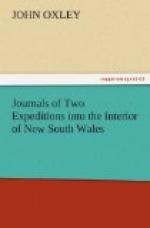In the map which accompanies the present Journal, every bounding range to the westward is laid down, from which it will appear that the north-west interior is nearly a perfect plain; the lower parts of which are certainly in most seasons under water. The highest land we crossed lies in lat. 31. S., and long. 151. 10. E. From this apparently dividing or principal range, the country gradually declines to the north-west; when, the hills terminating abruptly, the level land commences, over which is discharged all the waters that have their rise in this dividing range; and also those waters which rising in the hills (for they cannot with propriety be termed mountains) to the south-west, have the Lachlan River for their channel.
The nature of the country will be best explained by a reference to the Journal; generally speaking, it is fine and open. The bounding high lands to the north-west seem to take a direction nearly parallel with the coast line, and the evident declension of the country northerly affords strong ground for belief, that if those interior waters have any outlet to the sea [See Note at end of this paragraph.], it will be found in that direction; and I think the probability is that the waters falling westerly, will there approach the high tracts of country, much nearer than they do to the south-west. The whole country to the north of our track appeared so extremely open and practicable, that it offers in my opinion but few obstructions to a series of triangles being carried over it; the longest sides of which, being traced along the bounding high lands to the north-west, and carried as far northerly as the isthmus, which separates the gulf of Carpentaria from the sea to the eastward, would effectually set at rest all questions as to the existence of an interior sea. Farther north than this point, there can be no reasonable expectation of finding either waters or an outlet.
[Note: The observations made in the recent voyage of Lieutenant King along the west and north coasts preclude every reasonable hope of any opening being found on those coasts. The voyage which he is at present prosecuting will doubtless determine that point beyond all future question.]
So few natives were seen in the interior, that those extensive regions can scarcely be described as inhabited; some scattered families comprise the entire population, and the scanty remarks we were enabled to make satisfied us of the strict identity of this race of human beings with those of the coast. The same method of procuring their food, the same arms and utensils, are common to both. This remarkable similarity in the natives of different tribes extends also to the animal and vegetable productions of the country: the eucalyptus and casuarina; the kangaroo and the emu, with their various species, alike inhabit the cold regions of Van Diemen’s land, and the warmer latitudes within the tropics.




